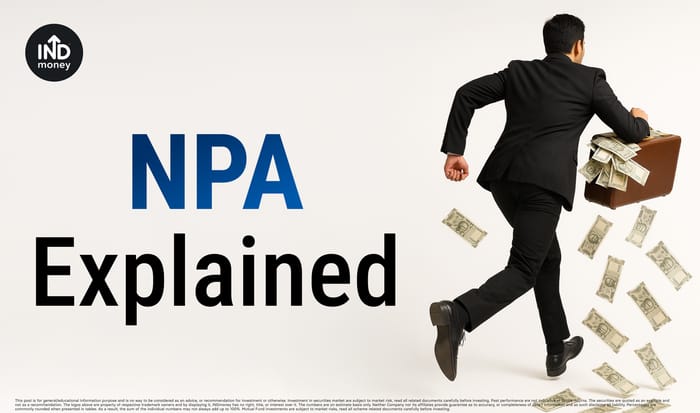
- What is NPA ? Gross vs Net NPA
- How much NPA do top banks have?
- But How can you check how much banks have set aside to cover for NPA
- What about provision of Top Banks
- Are there Early Detection System in Place
- Disclaimer
The very simple depiction of a banking business is this: banks accept deposits from customers and use that money to lend further. The difference between the interest they pay on deposits and the interest they earn on loans is called the net interest margin, which forms their primary source of income.
But here’s where a problem can arise.
What if the individual or organisation that borrowed the money stops repaying? In such cases, the bank not only loses out on the interest income but also runs the risk of losing the principal amount itself.
As an investor, it becomes important to know how much of a bank’s lending is in this risky, non-repaying category. That’s why banks are required to disclose these figures, and this disclosure is what we call NPA (Non-Performing Assets).
What is NPA ? Gross vs Net NPA
A loan is classified as an NPA if the borrower has not paid the interest or principal for more than 90 days in most cases. Now, NPAs are further divided into two types: Gross NPA and Net NPA.
Think of it like this: suppose you lend money to 10 people and expect a total EMI of ₹1 lakh each month. Out of this, ₹10,000 doesn’t come in because a few borrowers stop paying. At first glance, your loss seems to be the entire ₹10,000. But since you had already set aside a safety buffer of ₹4,000 anticipating such defaults, your actual loss is only ₹6,000.
In banking terms, the unpaid ₹10,000 is the Gross NPA, the total amount stuck in bad loans. After accounting for the ₹4,000 safety provision, the remaining ₹6,000 becomes the Net NPA, the real burden the bank is carrying.
How much NPA do top banks have?
Let’s look NPA of 3 listed Banks in India
| Bank | Gross NPA Ratio (GNPA) | Net NPA Ratio (NNPA) |
| HDFC Bank | 1.33% | 0.43% |
| ICICI Bank | 1.73% | 0.42% |
| Kotak Mahindra Bank | 1.42% | 0.31% |
But How can you check how much banks have set aside to cover for NPA
The answer lies in a measure called the Provision Coverage Ratio (PCR). It shows the percentage of NPAs that the bank has already provided for. For example, if a bank has bad loans worth ₹10,000 crore and has created provisions worth ₹6,000 crore, its PCR is 60%. A higher PCR means the bank is better prepared to absorb potential losses. These numbers are disclosed in the bank’s quarterly and annual results, so investors can track them regularly.
What about provision of Top Banks
| Bank | Provision Coverage Ratio (PCR) |
| HDFC Bank | 67.86% |
| ICICI Bank | 76.2% |
| Kotak Mahindra Bank | 80.38% |
Are there Early Detection System in Place
To ensure early detection of stress, banks follow a system called SMA (Special Mention Account).
When a borrower misses payments, banks don’t straightaway classify the loan as an NPA. Instead, SMA acts like a warning stage, an early alert system that helps banks and investors track loans showing the first signs of trouble.
The Reserve Bank of India (RBI) has defined three SMA categories, based on how long the payment has been overdue:
| SMA Category | Overdue Period | Explanation |
| SMA-0 | Up to 30 days | Payment delayed but overdue for a short period. Very early warning, can still be recovered quickly. |
| SMA-1 | More than 30 days and up to 60 days | Payment overdue for longer. The borrower is under pressure, and risk is rising. |
| SMA-2 | More than 60 days and up to 90 days | Payment overdue for a serious duration. Now it’s critical, and the chance of default is high. |
If the borrower still doesn’t pay after 90 days, the loan slips into the NPA category.
However this is a catch with SMA, banks need to report SMA only where the exposure (loan amount outstanding) is ₹5 crore and above to the CRILC (Central Repository of Information on Large Credits).
Disclaimer
Investments in the securities market are subject to market risks, read all the related documents carefully before investing. The securities are quoted as an example and not as a recommendation.This is nowhere to be considered as an advice, recommendation or solicitation of offer to buy or sell or subscribe for securities. INDStocks SIP / Mini Save is a SIP feature that enables Customer(s) to save a fixed amount on a daily basis to invest in Indian Stock. INDstocks Private Limited (formerly known as INDmoney Private Limited) 616, Level 6, Suncity Success Tower, Sector 65, Gurugram, 122005, SEBI Stock Broking Registration No: INZ000305337, Trading and Clearing Member of NSE (90267, M70042) and BSE, BSE StarMF (6779), SEBI Depository Participant Reg. No. IN-DP-690-2022, Depository Participant ID: CDSL 12095500, Research Analyst Registration No. INH000018948 BSE RA Enlistment No. 6428. Refer https://indstocks.com/pricing?type=indian-stocks; https://www.indstocks.com/page/indian-stocks-sip-terms-and-condition for further details.